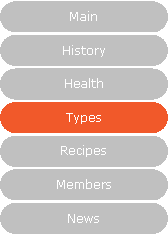


|
Types |

|
Apart from barley, paximadi was (and still is) made from plain and whole meal wheat flour, from migadi (equal portions of whole meal barley and wheat flour), triomigado (equal portions of barley, wheat and oat), migadi of oat (mixed oat and wheat flour or barley and oat). In many areas an “official” kind of paximadi from eptazymo bread is produced (in the villages around Mount Dicte). As far as shapes are concerned Cretan paximadi is separated in two big categories: dakos and kouloura. Dakos is a thick slice from an oblong bread. Kouloura is a round shaped bread cut through horizontally to separate the upper from the lower half; the “panokaukalo” (upper shell) and the “katokaukalo” (lower shell).
Soaking In general terms it must be comfortably eatable, soft but not soaked and there should be some crispy areas left. We’d better keep a bowl with water on the table and dip small portions of paximadi because once it has been soaked it must be consumed within a short time. |


|
TEAM OF CRETAN PAXIMADI PRODUCERS |

